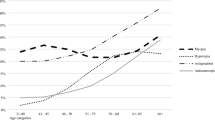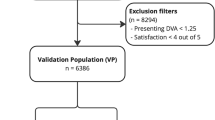Abstract
Purpose
To assess the prevalence of refractive errors, including myopia, high myopia, hyperopia, astigmatism, and anisometropia, in rural adult Koreans.
Methods
We identified 2027 residents aged 40 years or older in Namil-myeon, a rural town in central South Korea. Of 1928 eligible residents, 1532 subjects (79.5%) participated. Each subject underwent screening examinations including autorefractometry, corneal curvature measurement, and best-corrected visual acuity.
Results
Data from 1215 phakic right eyes were analyzed. The prevalence of myopia (spherical equivalent (SE) <−0.5 diopters (D)) was 20.5% (95% confidence interval (CI): 18.2−22.8%), of high myopia (SE <−6.0 D) was 1.0% (95% CI: 0.4−1.5%), of hyperopia (SE>+0.5 D) was 41.8% (95% CI: 38.9−44.4%), of astigmatism (cylinder <−0.5 D) was 63.7% (95% CI: 61.0−66.4%), and of anisometropia (difference in SE between eyes >1.0 D) was 13.8% (95% CI: 11.9−15.8%). Myopia prevalence decreased with age and tended to transition into hyperopia with age up to 60−69 years. In subjects older than this, the trend in SE refractive errors reversed with age. The prevalence of astigmatism and anisometropia increased consistently with age. The refractive status was not significantly different between males and females.
Conclusions
The prevalence of myopia and hyperopia in rural adult Koreans was similar to that of rural Chinese. The prevalence of high myopia was lower in this Korean sample than in other East Asian populations, and astigmatism was the most frequently occurring refractive error.
Similar content being viewed by others
Log in or create a free account to read this content
Gain free access to this article, as well as selected content from this journal and more on nature.com
or
References
Resnikoff S, Pascolini D, Mariotti SP, Pokharel GP . Global magnitude of visual impairment caused by uncorrected refractive errors in 2004. Bull World Health Organ 2008; 86 (1): 63–70.
Resnikoff S, Kocur I, Etya'ale DE, Ukety TO . Vision 2020 − the right to sight. Ann Trop Med Parasitol 2008; 102 (Suppl): 13–15.
Wang Q, Klein BE, Klein R, Moss SE . Refractive status in the beaver dam eye study. Invest Ophthalmol Vis Sci 1994; 35 (13): 4344–4347.
Katz J, Tielsch JM, Sommer A . Prevalence and risk factors for refractive errors in an adult inner city population. Invest Ophthalmol Vis Sci 1997; 38 (2): 334–340.
Attebo K, Ivers RQ, Mitchell P . Refractive errors in an older population: the blue mountains eye study. Ophthalmology 1999; 106 (6): 1066–1072.
Wu SY, Nemesure B, Leske MC . Refractive errors in a black adult population: the barbados eye study. Invest Ophthalmol Vis Sci 1999; 40 (10): 2179–2184.
Wong TY, Foster PJ, Hee J, Ng TP, Tielsch JM, Chew SJ et al. Prevalence and risk factors for refractive errors in adult Chinese in Singapore. Invest Ophthalmol Vis Sci 2000; 41 (9): 2486–2494.
Saw SM, Gazzard G, Koh D, Farook M, Widjaja D, Lee J et al. Prevalence rates of refractive errors in Sumatra, Indonesia. Invest Ophthalmol Vis Sci 2002; 43 (10): 3174–3180.
Wickremasinghe S, Foster PJ, Uranchimeg D, Lee PS, Devereux JG, Alsbirk PH et al. Ocular biometry and refraction in Mongolian adults. Invest Ophthalmol Vis Sci 2004; 45 (3): 776–783.
Xu L, Li J, Cui T, Hu A, Fan G, Zhang R et al. Refractive error in urban and rural adult Chinese in Beijing. Ophthalmology 2005; 112 (10): 1676–1683.
Sawada A, Tomidokoro A, Araie M, Iwase A, Yamamoto T, Tajimi Study Group. Refractive errors in an elderly Japanese population: the Tajimi study. Ophthalmology 2008; 115 (2): 363–370 e3.
He M, Huang W, Li Y, Zheng Y, Yin Q, Foster PJ . Refractive error and biometry in older Chinese adults: the Liwan eye study. Invest Ophthalmol Vis Sci 2009; 50 (11): 5130–5136.
Liang YB, Wong TY, Sun LP, Tao QS, Wang JJ, Yang XH et al. Refractive errors in a rural Chinese adult population the handan eye study. Ophthalmology 2009; 116 (11): 2119–2127.
Kim CS, Seong GJ, Lee NH, Song KC, Namil Study Group, Korean Glaucoma Society. Prevalence of primary open-angle glaucoma in central south Korea the Namil study. Ophthalmology 2011; 118 (6): 1024–1030.
Chylack LT Jr, Wolfe JK, Singer DM, Leske MC, Bullimore MA, Bailey IL et al. The lens opacities classification system III. the longitudinal study of cataract study group. Arch Ophthalmol 1993; 111 (6): 831–836.
Hyman L . Myopic and hyperopic refractive error in adults: an overview. Ophthalmic Epidemiol 2007; 14 (4): 192–197.
Saw SM, Katz J, Schein OD, Chew SJ, Chan TK . Epidemiology of myopia. Epidemiol Rev 1996; 18 (2): 175–187.
Saw SM, Tong L, Chua WH, Chia KS, Koh D, Tan DT et al. Incidence and progression of myopia in Singaporean school children. Invest Ophthalmol Vis Sci 2005; 46 (1): 51–57.
Fan DS, Lam DS, Lam RF, Lau JT, Chong KS, Cheung EY et al. Prevalence, incidence, and progression of myopia of school children in Hong Kong. Invest Ophthalmol Vis Sci 2004; 45 (4): 1071–1075.
Lee EK, Lee DB, Jin KH, Kim JM . The study of the correlation between axial length and refractive error in Korean children. J Korean Ophthalmol Soc 1993; 34 (7): 654–660.
Lee KE, Klein BE, Klein R, Wong TY . Changes in refraction over 10 years in an adult population: the beaver dam eye study. Invest Ophthalmol Vis Sci 2002; 43 (8): 2566–2571.
Acknowledgements
This study was supported by Alcon Korea, Merck Korea, Pfizer Korea, Taejoon Pharmaceutical, Zeiss Korea, and the Korean Ophthalmological Society.
Statement about conformity with author information
The IRB approval was before the study began. The study protocol adhered to the tenets of the Declaration of Helsinki and the municipal law of the Province of Chungcheonganm-do and was approved by the ethics committee of Chungnam National University Hospital and registered on the website Clinical Trials.gov (registration number: NVT00727168). Written informed consent was obtained from all participants.
Author contributions
Design of the study (KHP, CYK, and TWK), conduct of the study (JMK, KHP, CYK, and TWK), collection, management, and analysis of the data (YCY and JMK), interpretation of the data (YCY, JMK, and KHP), preparation of manuscript (YCY), review of the manuscript (YCY and JMK).
Author information
Authors and Affiliations
Consortia
Corresponding author
Ethics declarations
Competing interests
The authors have no proprietary or commercial interest in any of the materials discussed in the article.
Appendix
Appendix
The Namil Study Group, Korean Glaucoma Society:
Byung-Heon Ahn, MD, PhD, Department of Ophthalmology, Samsung Medical Center, Sungkyunkwan University School of Medicine
Myung Douk Ahn, MD, PhD, Department of Ophthalmology, College of Medicine, The Catholic University of Korea
Nam Ho Baek, MD, PhD, Saevit Eye Hospital
Kyu-Ryong Choi, MD, PhD, Department of Ophthalmology, Ewha Womans University School of Medicine
Seung-Joo Ha, MD, Department of Ophthalmology, Soonchunhyang University, College of Medicine
Gyu-Heon Han, MD, PhD, Doctor Lee’s Eye Clinic
Young Jae Hong, MD, PhD, Nune Eye Hospital
Ja-Heon Kang, MD, PhD, Department of Ophthalmology, Kyung Hee University College of Medicine
Changwon Kee, MD, PhD, Department of Ophthalmology, Samsung Medical Center, Sungkyunkwan University School of Medicine
Hong-Seok Kee, MD, PhD, Leeyeon Eye Clinic
Chan Yun Kim, MD, PhD, Department of Ophthalmology, Yonsei University College of Medicine
Chang-Sik Kim, MD, PhD, Department of Ophthalmology, College of Medicine, Chungnam National University
Hwang-Ki Kim, MD, Department of Ophthalmology, Konyang University College of Medicine, Kim's Eye Hospital
Joon-Mo Kim, MD, Department of Ophthalmology, Sungkyunkwan University School of Medicine, Kangbuk Samsung Hospital
Rights and permissions
About this article
Cite this article
Yoo, Y., Kim, J., Park, K. et al. Refractive errors in a rural Korean adult population: the Namil Study. Eye 27, 1368–1375 (2013). https://doi.org/10.1038/eye.2013.195
Received:
Accepted:
Published:
Issue date:
DOI: https://doi.org/10.1038/eye.2013.195
Keywords
This article is cited by
-
High prevalence of refractive errors in an elderly population; a public health issue
BMC Ophthalmology (2023)
-
Progression pattern of non-amblyopic Anisomyopic eyes compared to Isomyopic eyes
European Journal of Pediatrics (2023)
-
Prevalence and risk factors of refractive error in Qinghai, China: a cross-sectional study in Han and Tibetan adults in Xining and surrounding areas
BMC Ophthalmology (2021)
-
Effects of low and moderate refractive errors on chromatic pupillometry
Scientific Reports (2019)
-
Refractive Errors in Northern China Between the Residents with Drinking Water Containing Excessive Fluorine and Normal Drinking Water
Biological Trace Element Research (2016)



